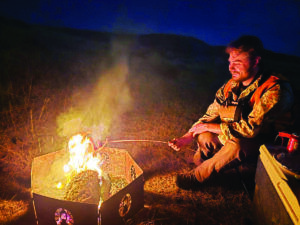
by John Dowd
Montana is big. This may seem like an understatement, but it really is hard to get one’s head around. If you are familiar with the states of Georgia, Alabama and Mississippi, as they are lined up together, you’ll notice that crossing the three is about the same distance as crossing from one side of Montana to the other. More than half of Montana is plains, and for the early peoples, both native and pioneer, it was no small feat to go from one side to the other. As it were, supplies were in short supply.
During a hunt a couple weeks ago, we went to the eastern part of the state to chase after pronghorn. While there, we camped out on the plains, just like those early west-goers. Another thing keen folk may notice is that there are not a lot of trees on the plains. Given this, the question may come up: how did they have campfires? And we found ourselves in the same predicament.
We had fuel for cooking, and haven’t had fires there in the past, but this year, camping out on public land, we wanted to have campfires in the cool nights.
The answer came in a strange form for people today. Something that was quite abundant back then, and still today, were cow patties. Pioneers moving droves across the West, as well as Indians following bison herds, could easily find and gather these dried excrement piles. And, as it turns out, they burn really well.
On our hunt, my hunting partner and I decided to give it a try. He, at first, was not receptive to the idea. He would have preferred to burn all the sagebrush in the area, which would have been what it would have taken for just a single night. That sage burns fast. However, I convinced him to give it a try, and to use the patties. I was not sure how that would turn out myself. I had read about doing so, in historic documents, as well as in books and accounts, but I had no idea what it would truly be like. But what did we have to lose?
After starting up a bit of sage as a base, I threw on a couple patties, or chips, as they were called in the Old West. Within seconds, they were alight. To our astonishment, no smell, very little smoke, and a hot and wonderful coal base is what resulted. In fact, upon the end of our trip, and after three nights of cow-patty fires, we both left with the assurance that we had now found our favorite campfire fuel.
It was true, too, those accounts I had read. I remember reading about several scenarios where chuck-wagoneers preferred the chips over everything else they could burn. They preferred them as a cooking fuel especially, and even had fights with greenhorns less confident in the idea of drinking a cup of coffee boiled over cow crap. In our experience, the chips dry out fast, even with a substantial rain. They burn hot and long, and cook down to an even, consistent and very hot coal base. In fact, there was no sparking or spitting and the fire burned slow and safe. So much so that it really was a lot like coal. We started to compare these chips to Dura-logs, essentially a natural version. We even cooked a few meals over the patties, with confidence.
It started as a joke and something new to try, but turned out changing the way we both view fire. Really, people of the time, and in these circumstances, must use what they have available. People in Third World countries, and remote parts of earth, still use cow chips to heat their homes and to cook their food. On islands, they use coconuts. In the mountains, a good pine or oak will do. In the jungle, halved bamboo burns fast, but hot. On the coast they use driftwood. In the plains and on steppes, they use cow patties.
It is interesting, just to look at it from another perspective, what we do with fire, and all it achieves. It really is so essential, and people are resourceful. It makes a person consider everything they might be able to use as fuel, to cook, heat, make light and even protect. In a pinch, I really would advise trying the chips. You won’t regret it.